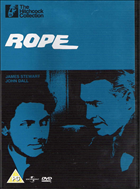
Rope
Year: 1948
Dir: Alfred Hitchcock
Cast: James Stewart, John Dall, Farley Granger
1948- film Rope is a perfect example of director Alfred Hitchcock’s inventive, innovative movie-making. Drawing inspiration from a sensational, real-life murder-story in the 1920s (Leopold-Loeb murder case), this film explored the darker recesses of human mind and while doing that achieved some seemingly impossible technological victories.
The film opens up with a murder scene- two young men strangling a man and dumping his lifeless body into an old chest. High-society friends and flat-mates Brandon (John Dall) and Phillip (Farley Granger) have killed their friend David- not for any other cause but just to experience the ‘thrill’ of it! ‘Most men commit murders for crime but some do it as a privilege’- that’s their warped philosophy behind the dastardly act. In their minds, they are just trying to follow their old school-teacher Rupert’s (James Stewart) controversial teachings that intellectually superior people have a right to kill intellectually inferior people.
Not just remaining content with the killing, the duo decides to do a sort of celebratory victory-lap for their ‘perfect murder.’ Within an hour of the murder, they throw a party in the same room, in fact using the chest containing the dead body as the dinner table! Amongst guests for this macabre party, they have invited David’s old father, David’s fiancée and also Rupert. Now the cat-and-mouse game begins.
Brandon- the aggressor in the duo is gloating over his ‘ingenious act’, even going to the extent of dropping none-too-subtle hints about murder; Phillip- the meeker one is fidgeting nervously; Rupert is getting increasingly suspicious and the rest are plain uncomfortable about David’s disappearance. Amidst suspense and drama spiced up by Hitchcock-brand of black humor the film reaches its climax. What really happens in the end?
Apart from a taut story, convincing performances and a bold theme presenting the moral and ethical arguments for and against inhuman arrogance springing out of so-called superior intelligence, the film impresses with its technical mastery. The entire film takes place inside an apartment, seemingly as one continuous shot and with practically no background music. Through the apartment windows, New York skyline goes on changing its hues as the day turns into night and all of this effect was achieved through a cleverly erected set and imaginative lighting. It was Hitchcock’s first colour film and considering the huge size of camera and film-equipment, it was nothing short of a technical marvel!


